This Rosy Boa Care Sheet is the first in my Popular Pet Reptiles series, and it’s no coincidence that I’ve chosen to focus on them. The species (well, technically two now) was one of my favourite childhood pets. Keep reading to find out why!
Last updated on February 1st, 2023 at 09:45 am
The Rosy Boa is a very small, delicate-looking boa species from the arid south-western USA and Northern Mexico. Though shy and secretive, its captive care is incredibly easy. If given the correct heat, humidity and enclosure size this gentle snake can have a lifespan of 20 years or more.

Rosy Boa Species
Before going any further, we need take a quick look at Rosy Boa (Lichanura) taxonomy. Though most certainly a Boa, the taxonomy of Lichanura to the species level is complicated, and occasionally gets revised or disputed. So, what I’m going to tell you is the current taxonomy at the time of writing.
In the past, Rosy Boas have been divided into several subspecies based on locality and pattern. This is no longer the case. In a 2008, a study by Wood et al. determined that Rosy Boas probably belong to two species and made previously named subspecies irrelevant.
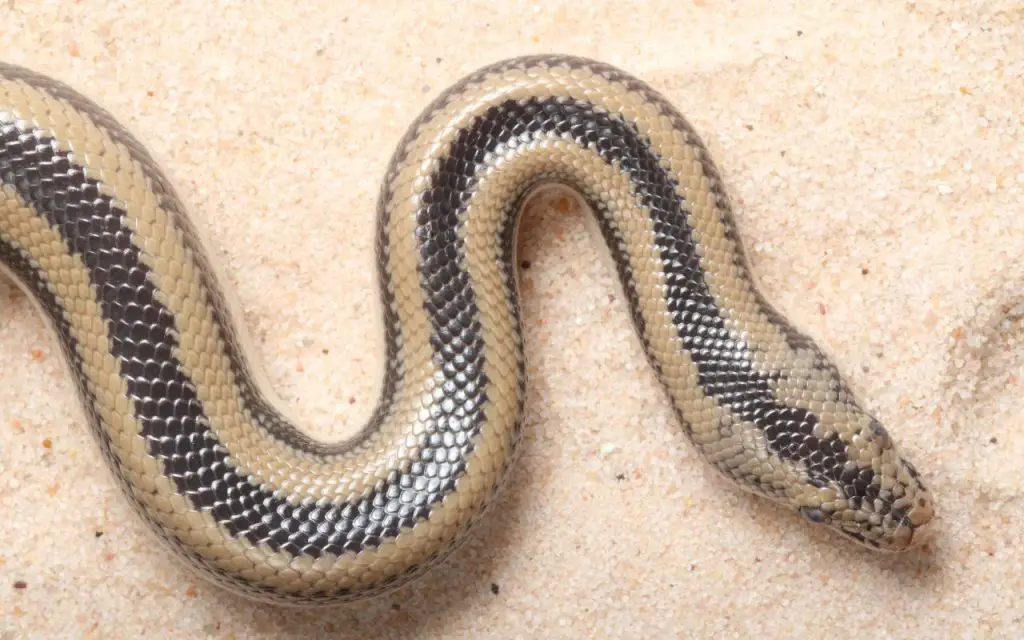
Lichanura has been divided into two species
Based on mitochondrial DNA, this may or may not be further disputed in the future. At this time, however, the outcome is that all Lichanura naturally occurring in southern California, extreme northern Baja California and western Arizona are classed as Lichanura orcutti. They now have the common name “Rosy Boa” or “Northern Three Lined Boa”. This Lichanura orcutti species includes the now-defunct subspecies L. t. roseofusca (the Coastal Rosy Boa) and L. t. gracia (the Desert Rosy Boa).
All Lichanura occurring in mid and southern Baja California, Baja California Sur, extreme southern California, extreme southern Arizona, and north-western Mexico have been reclassified as Lichanura trivirgata. For its part, Lichanura trivirgata contains the now defunct subspecies L. t. saslowi (the Baja Rosy Boa), and L. t. trivirgata (the Mexican Rosy Boa). The common names used for this species are usually “Rosy Boa” (again!), “Mexican Rosy Boa” or “Three Lined Boa”.
To keep things simple, I’m going to refer to Lichanura orcutti as the Northern Three Lined Boa and Lichanura trivirgata as the Three Lined Boa. I’ll say “Rosy Boas” when referring to both species in general. Hopefully, this will catch on and make everyone’s life easier!
For a range map of where each species occurs, I suggest visiting Californiaherps.com.

It’s best to keep track of which species we’re keeping!
This may sound a little complicated, but it’s important to understand which species is which. When breeding animals in captivity, we don’t want to hybridise species without even knowing. That kind of thing could lead to problems re-introducing them if their wild relatives ever die out.
The problem is that most keepers and breeders still refuse to accept this new classification and prefer to go by locality. But, then again, localities shouldn’t be hybridized either, so maybe they have a point!
The bottom line is that if you get into breeding Lichanura, you will need to learn about both the scientifically recognised species and the various localities. If you’re just interested in them as pets, however, gaining an understanding of the two species is enough.
Rosy Boas for Sale
To this day, Rosy Boas are still not as widely available as some of our other favourite pet snake species like Ball Pythons and Boa Constrictors.
Personally, I find this really dissapointing. They’re small, easy to keep and stunning to look at. This scarcity also keeps their price relatively high – bummer!
Nonetheless, if you head over to Morphmarket you can sometimes find captive bred neonates available. If you are in North America, however, make sure they are indeed captive bred, as wild collection of this species has been a problem in the past.
Rosy Boa Size and colors
In both species the scales are smooth and the adult body proportions should be slimmer than Ball Pythons, but still chunky.
The Northern Three Lined Boa (Lichanura orcutti) is the species that gave these snakes their common name. This is because specimens from certain localities have a beautiful rosy colouration to their ventral scales.
Born live, they start out life as slim, 10 -12inch (25-30cm) neonates, then grow rapidly to a length of 18-30 inches (45-76cm), with males being smaller than females. In the same coastal areas where the species has the rosy ventral colouration, females have been recorded at over 40 inches (101cm). In general, however, full grown Rosy Boas rarely exceed 36 inches (90cm).
On their back they have three dorsal stripes that can be very faded orange, dark orange, or tan. The background colour is cream or grey. In some areas the stripes are broken and blend into the background almost completely. In some parts of Arizona, they may also have chocolate-coloured stripes.
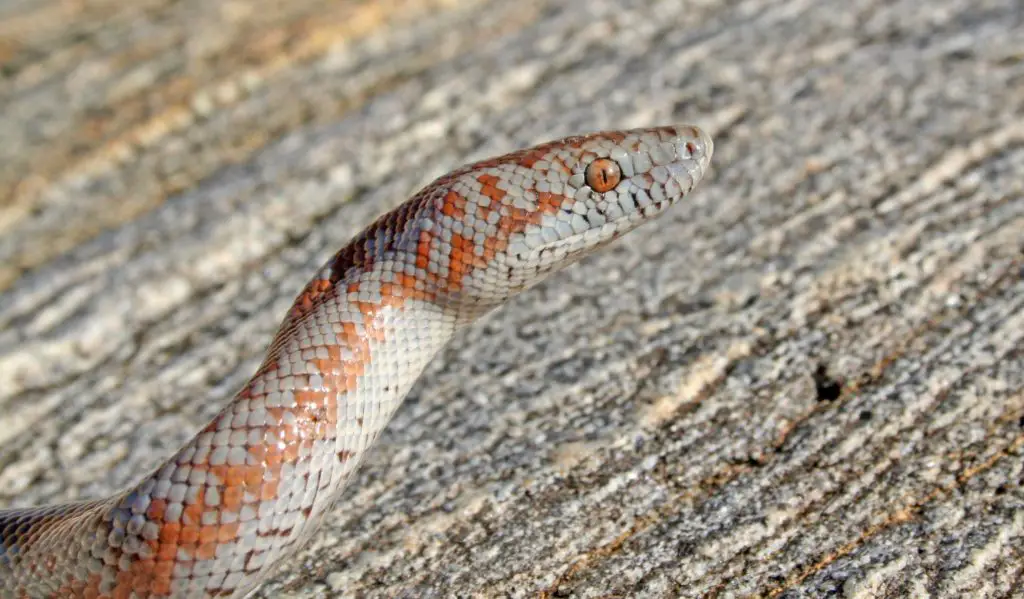
These two species are incredibly similar!
The Three Lined Boa (Lichanura trivirgata) starts life at around the same size as Lichanura orcutti, but rarely exceeds 30 inches (76cm) as an adult.
As for colouration they also have three dorsal stripes, but they tend to be more defined – and more colourful. In specimens from Baja California, the stripes can be a beautiful dark orange colour set against a cream/grey background. This locality is my personal favourite!
In specimens from southern Arizona, Baja California Sur and northwest Mexico, the stripes can be dark brown or black on light cream. This is also a very striking colour combo.
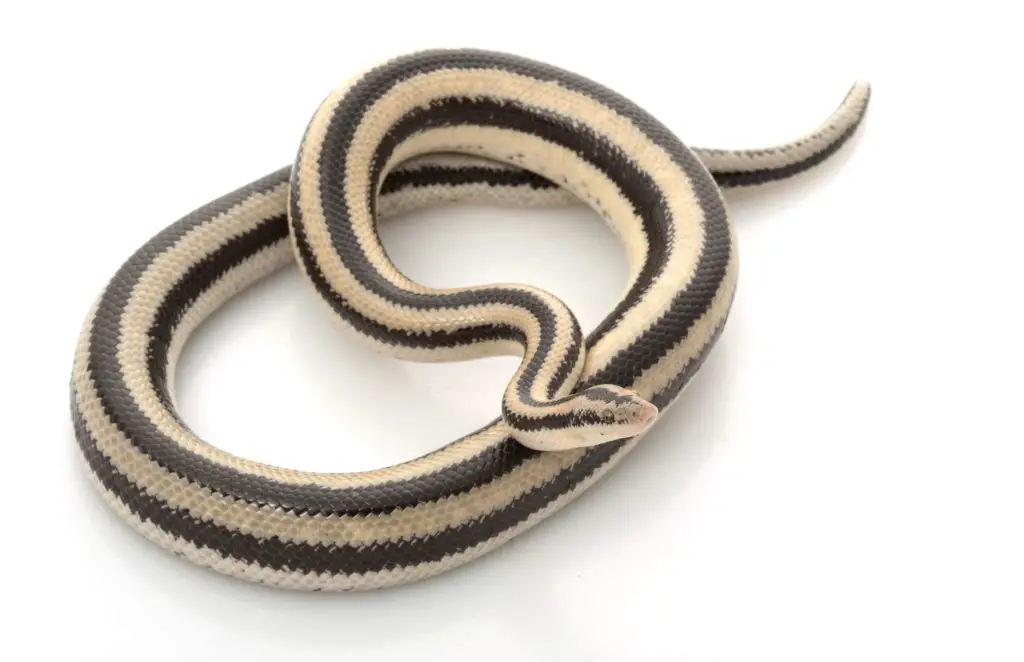
Rosy Boa morphs
Rosy Boas also occur in a variety of morphs. The most popular of these are axanthic (missing yellow pigment), anerythristic (lacking red pigment), albino, and snow (both albino and anerythristic).
In general, it’s fair to say morphs of this species are still quite uncommon on the market. They also tend to come in at a higher price. Unless you plan on breeding them down the line, it may be best to go just go for a normal Rosy Boa. After all, they’re beautiful as they are.
Rosy Boa habitat and natural history
Both species live in arid areas and spend much of their time under cover. In some areas they occupy rocky slopes, hiding in crevices. In other, flatter areas they also use rodent burrows to hide in. this has only recently been established, as it was previously believed that they never left rocky areas. Whichever habitat they occupy, they are not known to be great climbers. Don’t let this fool you though – they are still excellent at escaping from enclosures!

They are mostly active at night but can become crepuscular when temperatures drop too low for night-time foraging. Annual activity also varies due to temperature. In the northern parts of their range Lichanura will brumate from December to February, whereas in the south they may be active all-year round.
Personally, I wouldn’t brumate pet Lichanura unless planning on breeding them. Keep their heat consistent and they should continue their activity and feeding through the winter. Some people disagree with me on this however, saying that brumation is necessary for Lichanura longevity. Don’t take just my word on this! Do some research by contacting long-term keepers and breeders, then decide where you stand on this point before buying one.
When it comes to breeding, both species tend to breed in spring and give birth to around 6 babies in late summer or fall. Adults breed at the age of 2 to 3 years after growing rapidly to full size. As with many other species, females will take a year off from breeding if they lack fat reserves.

Did you know?
Rosy Boas are exceptionally chilled out. There are currently no verified records of either species engaging in male-male combat, or territorial behaviour.
A study from 2005 even found that individuals of Lichanura orcutti had a lot of range overlap. Males occupied overlapping home ranges with other males, and females did with other females. This is possible proof of a lack of territorial behaviour in the species.
In a nutshell, Rosy Boas do appear to be more chilled out, and less territorial than many other snake species.
Do Rosy Boas make good pets?
Rosy Boas make great pets. In fact, I think they one of the best snakes for beginners. I still can’t figure out why more people aren’t keeping them!
They are exceptionally docile, relaxed animals that are beautiful to look at. They also reach a small size, feed readily and are generally very hardy.
Overall, I would consider Rosy Boas as easy to keep as Ball Pythons, and almost as easy as Corn Snakes. The only real caveat is that both species of Lichanura like it dry! This means that they are more susceptible to illness if kept too damp, and plastic tubs are not generally the best option for housing them.
If you are trying to decide whether to buy a Rosy Boa or a Ball Python, you can read a more detailed comparison here.
The best features of Rosy Boas include:
- a long lifespan
- small size
- easy and cheap to feed
- docile temperament
- hardy if kept dry
- beautiful color and pattern variations
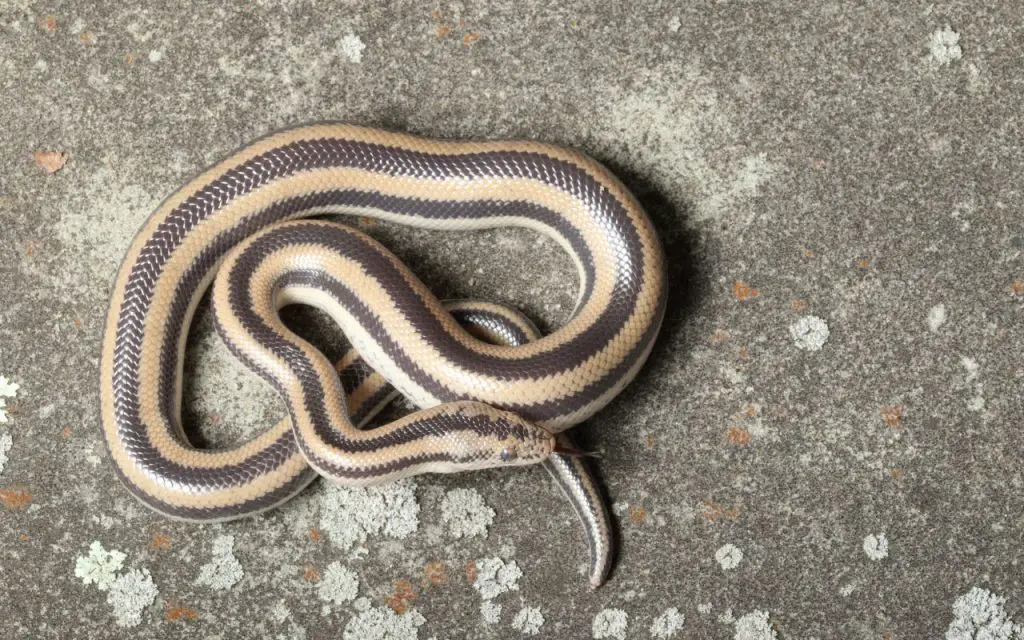
Rosy Boa Enclosure
When setting up a Rosy Boa enclosure, your main concerns should be ventilation and security. By ventilation I mean making sure that the enclosure has adequate mesh or vents to allow for excellent air circulation. Humid or stagnant air is a big no-no!
When it comes to security, this is not just to make the snake feel safe, it’s to prevent escape. Rosy Boas are mediocre climbers, that will act shy or lazy 90% of the time. But somehow, they are incredible escape artists. I learnt this the hard way as a kid, when my awesome Three Lined Boa escaped, never to be seen again!
If you look at the YouTube video below you can see that the creator uses the Exo Terra Medium enclosure for his adult Rosy Boas, and this enclosure is ideal in my opinion. They are 24x18x18inches (60x45x45cm) and have a mesh top that offers great ventilation.
Be wary of providing an enclosure that is over 36 inches (90cm) for this species, as, just like Ball Pythons, this can make them nervous.
For baby Rosy Boas, you can use plastic faunariums (with the mesh-type plastic lids) or 5-10gallon tanks. Again, the focus should be on adequate ventilation and a secure lid.
Note: read our full article on Rosy Boa enclosures.
Always provide hiding places for Rosy Boas
Something else you may notice in the video is that the creator provides several hides for his snakes. This is important as it allows the snake to spend most of its time hiding – which reduces stress and helps with thermoregulation. You should provide at least two hides for this species, one in the warm end of the enclosure and one on the cool end. Personally, I also think that adding one midway between these areas is also a good idea.
Exo Terra cave hides or pvc piping can both make good hides. Just make sure they don’t have any rough bits.
For substrate, small chip aspen is a good option, as is paper fibre. As with any snake species, cedar and pine are harmful and should never be used.
Finally, Rosy Boas seem to be happiest when kept alone.
Rosy Boa temperature and humidity
Both species of Lichanura are desert dwellers but both are mostly nocturnal. This means that the scorching heat you would provide for diurnal desert species is inappropriate.
These guys do incredibly well when provided with a heat mat controlled by a pulse-proportional thermostat. The mat should be set up underneath the tank with the thermostat probe stuck between it and the underside of the glass.
If you prefer, you can instead use a ceramic heat emmiters. These are ideal for nocturnal animals that require low humidity, though they are a little more pricey. Again, they should be used with a pulse-proportional thermostat.
Set the thermostat temperature to 90-95F (30-35C) and keep an eye on the temperature on the inside of the tank by using a digital thermometer probe or infrared thermometer gun. This temperature will be ideal for the warm end. Let the temperature fall to 80-85F(26-29C) at night.
Ideally, the cool side of the enclosure should sit at 75-80F (24-26C), and drop to 70-75F (21-24C) at night.
Don’t forget, if the snake is constantly roaming the enclosure, it usually means it is too warm.
For humidity, 30-40% is a good level to aim for. The best way to achieve this is to only provide water in a small water dish for a couple days, every few weeks. Enclosures with mesh lids also help maintain low humidity as does using a substrate that dries out nicely.
Desert species will drink a lot of water in one go. Provide water a few days before feeding so that your snake has time to take it in. Otherwise, some Rosy Boas will drink as much as they can, then eat, then puke…
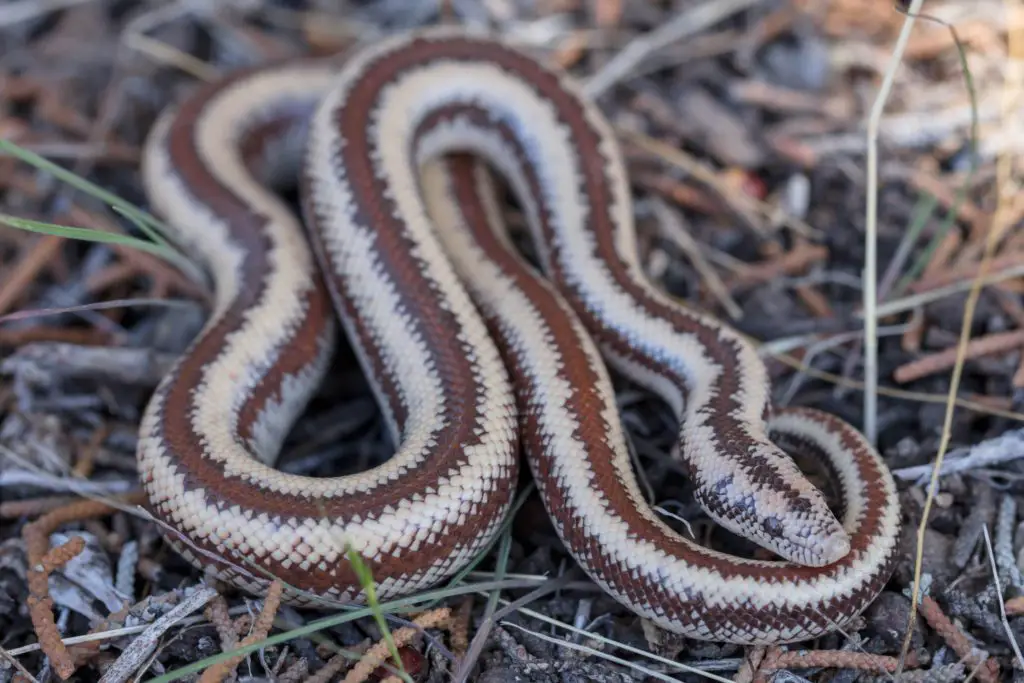
Lighting
Like many other nocturnal snakes, Rosy Boas don’t bother basking unless they are too cool. Their bodies have evolved to extract Vitamin D from their food and providing UV light is generally considered to be unnecessary.
What I will say though, is that unlike Ball Pythons, these snakes don’t seem to be bothered by bright light if they have nice dark hiding places. What’s more, a desert terrarium set up can look really cool with lighting installed.
Also, if you don’t plan on brumating your snake, a light on a 12hr cycle can help stop them from brumating of their own accord. This is one way in which UV light could be beneficial. That said, you could also just leave the light on in the room to mimic the day-night cycle!
My verdict is: if you want to give them a UV light to enhance their setup – go for it! If you don’t then, don’t. Just make sure there is ambient light in the room for 12 hours a day, without sun shining directly on the tank.

Do Rosy Boas like to be held?
For a while there’s been this rumour that some Rosy Boas are nippy… I honestly don’t know where this has come from! They are one the most gentle, docile snakes you could encounter. Handle them once a week while they grow up and they will be dog-tame – that is all there is to it!
The only possible explanation for the nippy rumour is that these snakes have a good feeding response and will get excited if they think food is coming. I guess this could lead to accidental bites, which wouldn’t exactly hurt much anyway! Again, this never happened to me, so I’m speculating.
If you’re concerned about being bitten during feeding, you can follow the exact same tips I outlined in this previous post: Do Ball Pythons Bite?
What I will say is that from my experience, Rosy Boas don’t mind being held at all if it’s gentle and stays at 5 to 10 minutes, once or twice a week.
What do Rosy Boas eat?
In the wild they eat a wide range of things, with evidence suggesting they may even prey on bats in some areas. Notwithstanding, captive individuals seem to have a liking for mice and accept them frozen-thawed, without any issues. You just have to make the mouse “dance around” a bit to get them interested.
I would suggest feeding pinkie mice to baby Rosy Boas every 5 days. As the snakes grow you can increase the size of the mice in line with their girth. Usually this means that an adult will end up feeding on small mice. At this age, only feed the snake every 10-14 days as its metabolism will have slowed down. If you overfeed them they can get obese quite quickly.
When preparing frozen-thawed mice, I recommend thawing them out in warm water, inside a sandwich bag for an hour. Make sure they’re nice and warm all the way through (yes, you need to squeeze them to find out!).
Note: read our full article on Rosy Boa diet and feeding.
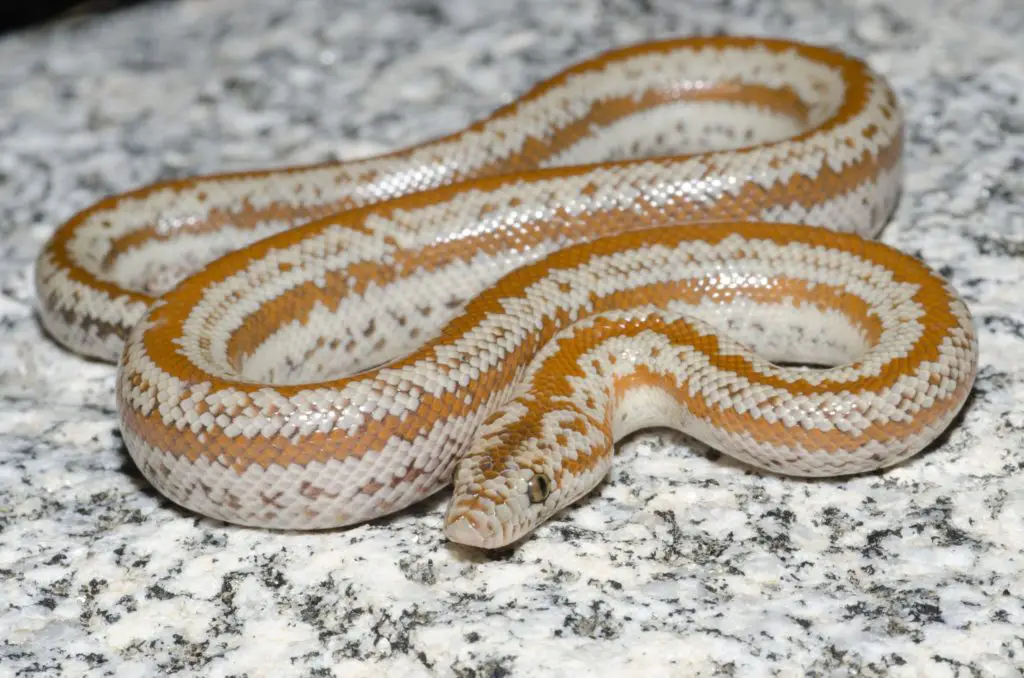
Rosy Boa Care Summary
| Temperature: | 90-95F (30-35C) on the warm end and 75-80F (24-26C) on the cool end. Drop to 80-85F(26-29C) and 70-75F (21-24C) at night. |
| Humidity: | 30-40% |
| Favourite food: | Mice |
| Enclosure size: | 10-12inches (25-30cm) long for juveniles, 24-36inches (60-90cm) for adults |
| Activity rythm: | Nocturnal |
| Lighting needs: | UV lighting not necessary, but ambient lighting beneficial |
| Availability: | Average in North America, very poor in Europe and elsewhere |
How do Rosy Boas compare to other pet snakes?
What could be cooler than a miniature, friendly boa? Add to that the fascinating fact they are a snake from a tropical superfamily which has evolved to live outside of the tropics, and you have one of my favourite species.
Rosy Boas are an easy species to keep all round; being small and having a much better feeding response than a lot of Ball Pythons. They also live a long time, up 20 years or more.
Even if you do decide to brumate them, this isn’t too hard to do. You will need a wine chiller or one of the newer incubators with a cool setting. Just make sure you research brumation well in advance if you decide to do it. As I said before, I never did with my Lichanura, but some people disagree with me on this point.
The only real issue with these snakes is that you must get their humidity right. Scale rot (necrotizing dermatitis) and Respiratory infection will be the result if not. If you know you can get this one thing right, Rosy Boas make GREAT pets!
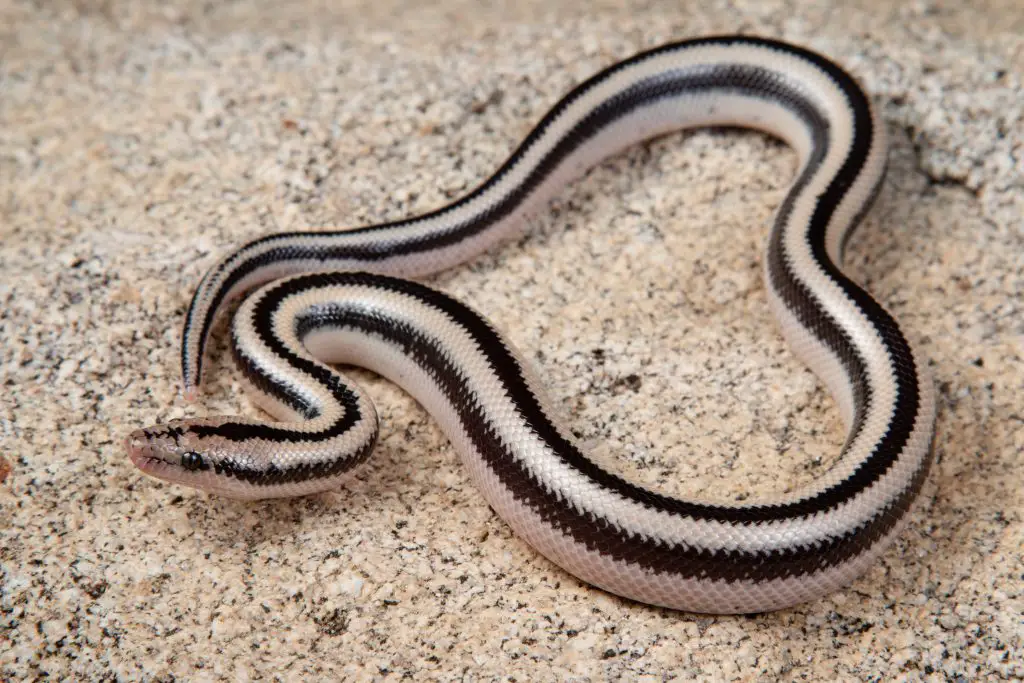
Key points to remember about Rosy Boa husbandry
- The only thing these snakes are picky about is their humidity levels. Rosy Boas only need fresh water and the presence of a water bowl for a couple of days, every few. Humidity that is too high will impair their immune system and lead to illnesses like respiratory infections.
- Your Rosy Boa’s enclosure must have good ventilation to maintain that low humidity. This means mesh-topped glass tanks like the Exo-Terra range work great (and look great). If you wish to use plastic tubs, try to cut in whole mesh inserts, rather than just holes.
- Wild Rosy Boas come from the Southwestern United States and Mexico, where they eat a variety of live prey. In captivity though, the best diet is frozen-thawed mice. These should be captive-bred by a reputable supplier to ensure they were fed a good diet and therefore carry the correct nutritional value for your pet snake.
- These snakes are good eaters, and an adult Rosy Boa may become obese if fed more than one or two adult mice every 10-14 days.
- Being nocturnal, neither species needs UVB lighting. This means you can use ceramic heat emitters or heat mats as 24hour heat sources for them.
- Your snake will need a hiding place at each end of the enclosure’s temperature gradient (both the cool end and warm end). A baby Rosy Boa will also need a smaller enclosure to help it feel safe.
